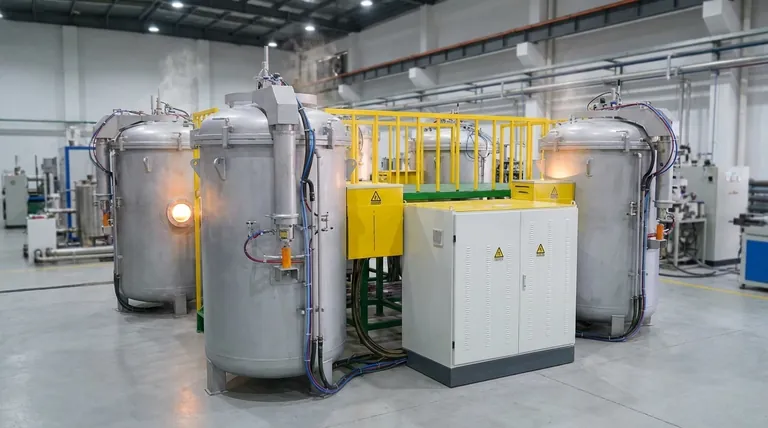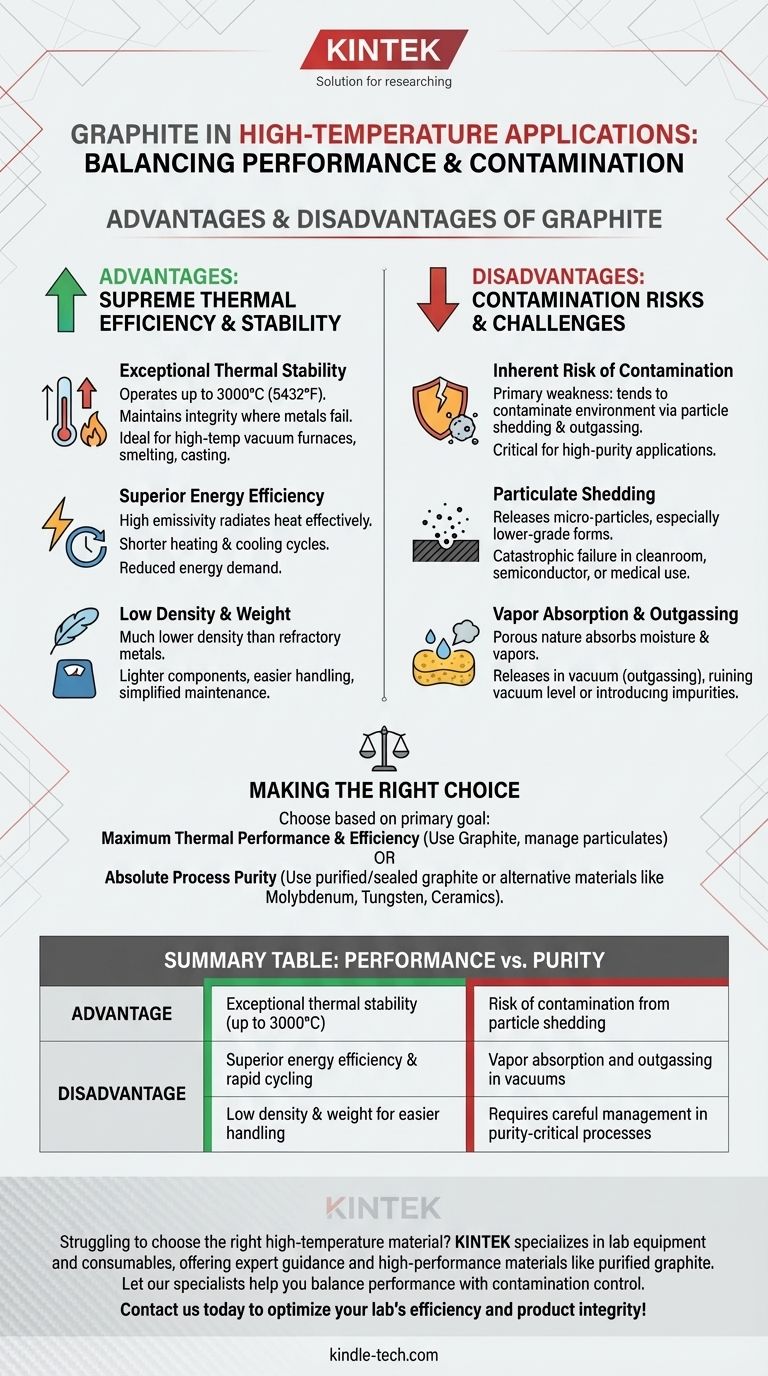고온 응용 분야에서 흑연은 극단적인 소재입니다. 대부분의 금속이 실패하는 온도인 최대 3000°C에서 작동할 수 있는 탁월한 열 성능을 제공합니다. 주요 장점은 뛰어난 에너지 효율성, 낮은 무게, 빠른 가열 및 냉각 주기입니다. 그러나 주요 단점은 입자 탈락 및 증기 흡수로 인한 상당한 오염 위험입니다.
흑연의 핵심적인 상충 관계는 분명합니다. 극한 환경에서 최고의 열 효율성과 안정성을 제공하지만, 이러한 성능은 민감한 공정에서 신중하게 관리해야 하는 잠재적인 오염의 대가를 치러야 합니다.
까다로운 환경에서 흑연의 핵심 장점
흑연의 고유한 원자 구조는 특히 강렬한 열과 관련된 특정 고부하 응용 분야에서 매우 중요하게 만드는 특성 조합을 제공합니다.
뛰어난 열 안정성
흑연의 가장 높이 평가되는 특성은 극한 온도에서 작동하는 능력입니다. 최대 3000°C(5432°F)에 이르는 조건에서도 구조적 무결성과 특성을 유지하며, 이는 대부분의 금속 및 많은 세라믹의 작동 한계를 훨씬 능가합니다.
이로 인해 고온 진공로, 제련, 주조와 같은 응용 분야에서 필수적인 재료가 됩니다.
우수한 에너지 효율성
흑연은 상당한 열을 흡수할 수 있지만, 전반적인 에너지 균형은 놀라울 정도로 효율적입니다. 높은 방사율을 가지고 있어 열 에너지를 매우 효과적이고 균일하게 방출합니다.
이는 가열 및 냉각 시간을 단축하여 전체 공정 주기 시간을 줄이고 유도 가열로와 같은 장비의 에너지 요구 사항을 낮춥니다.
낮은 밀도와 무게
비슷한 온도 범위에서 사용될 수 있는 내화 금속과 비교할 때, 흑연은 훨씬 낮은 밀도를 가집니다.
이는 부품을 더 가볍게 만들고 취급을 용이하게 하며 대규모로로 구조에 필요한 지지 질량을 줄여줍니다. 또한 현장 수리 및 교체를 단순화합니다.

상충 관계 이해하기: 흑연의 주요 단점
흑연을 유용하게 만드는 특성 자체가 상당한 문제를 야기합니다. 다공성이며 층상 구조인 특성은 가장 중요한 단점의 원인이 됩니다.
오염의 내재적 위험
흑연의 주요 약점은 작동 환경을 오염시키는 경향입니다. 이는 입자 탈락과 가스 방출이라는 두 가지 주요 방식으로 발생합니다.
이 한 가지 문제는 순도가 최우선인 응용 분야에서 흑연 사용을 결정하는 요인이 되는 경우가 많습니다.
입자 탈락
흑연은 비교적 부드러우며, 특히 등급이 낮거나 결합된 형태의 경우 표면에서 미세 입자를 방출할 수 있습니다.
클린룸 환경, 반도체 제조 또는 의료 응용 분야에서 이러한 부유 탄소 입자는 치명적인 제품 고장이나 오염을 유발할 수 있습니다.
증기 흡수 및 가스 방출
흑연은 다공성이며 대기 중에서 수분, 세척제 및 기타 증기를 흡수합니다. 특히 진공 상태에서 가열되면 가스 방출(outgassing)이라는 과정을 통해 이러한 갇힌 분자를 방출합니다.
이러한 가스 방출은 로의 진공도를 망가뜨리거나 민감한 공정에 원치 않는 화학적 불순물을 도입하여 최종 제품의 무결성을 손상시킬 수 있습니다.
귀하의 응용 분야에 맞는 올바른 선택
흑연을 선택하려면 타의 추종을 불허하는 열 성능과 오염을 제어해야 하는 중요한 필요성 사이의 균형을 맞추어야 합니다. 귀하의 주요 목표가 올바른 선택인지 여부를 결정할 것입니다.
- 주요 초점이 최대 열 성능과 에너지 효율성인 경우: 흑연은 2000°C를 훨씬 초과하는 온도에서 작동하는 공정에 탁월하며 종종 필수적인 선택이며, 미세한 탄소 입자를 허용하거나 관리할 수 있습니다.
- 주요 초점이 절대적인 공정 순도와 오염 방지인 경우: 고순도 밀봉된 등급의 흑연에 투자하거나 몰리브덴, 텅스텐 또는 고급 세라믹과 같은 대체 재료를 고려해야 합니다.
궁극적으로 흑연을 선택하는 것은 놀라운 내열성을 우선시하는 동시에 공정에 미치는 환경 영향을 완화할 책임도 받아들이는 엔지니어링 결정입니다.
요약표:
| 장점 | 단점 |
|---|---|
| 뛰어난 열 안정성(최대 3000°C) | 입자 탈락으로 인한 오염 위험 |
| 우수한 에너지 효율성 및 빠른 주기 | 진공 상태에서의 증기 흡수 및 가스 방출 |
| 취급이 용이한 낮은 밀도 및 무게 | 순도 중요 공정에서 세심한 관리가 필요함 |
실험실 공정에 적합한 고온 재료를 선택하는 데 어려움을 겪고 계십니까? KINTEK은 실험실 장비 및 소모품 전문 기업으로, 정제된 흑연과 같은 고성능 재료에 대한 전문적인 안내를 제공하여 특정 열 및 순도 요구 사항을 충족합니다. 저희 전문가들이 성능과 오염 제어 사이의 균형을 맞추도록 도와드리겠습니다. 지금 문의하여 실험실의 효율성과 제품 무결성을 최적화하세요!
시각적 가이드




















